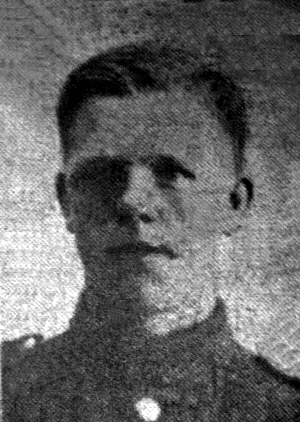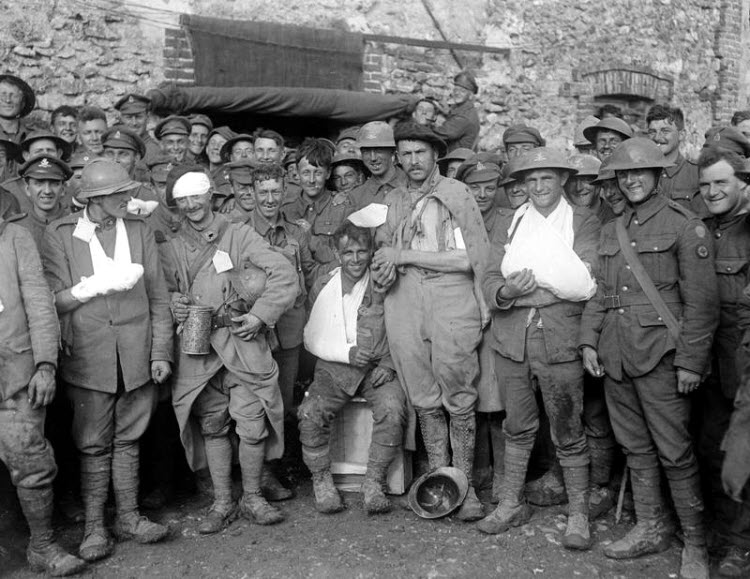
Harry Kellett was born in Morley in 1899, the sixth child of seven children born to coal miner Joseph Kellett and his wife, Emma (nee Jackson), who married at Batley All Saints Church on Christmas Day 1881. The couple had twelve children from their marriage, but sadly five died before April 1911. With the exception of their last child, born in Ossett in 1903, all of the children, five boys and two girls were born in their parents’ home town of Morley.
The family were living in Churwell, Morley in 1901, but Joseph Kellett and his wife and family came to live in Ossett in about 1903, and by 1911 they were living at 13, Hilda Street, Ossett. Harry, aged 12, was still at school.
Harry Kellett’s army service record has not survived, but it is known that he enlisted at Dewsbury and joined the 5th Battalion, King’s Own Yorkshire Light Infantry Regiment (KOYLI). He enlisted in March 1917 and embarked for France in December 1917 shortly after his 19th birthday. He was posthumously awarded the British and Victory medals.
The 5th Battalion KOYLI was formed on the 2nd February 1918 when the Territorial 1st/5th and 2nd/5th Battalions of KOYLI were amalgamated into the new 5th Battalion, KOYLI and transferred to the 187th Brigade in 62nd (2nd West Riding) Division. Because of heavy losses during 1917 in both the 1st/5th and 2nd/5th KOYLI, it was necessary to amalgamate the two battalions into one battalion.
Private Harry Kellett died in the Battle of Tardenois, which raged from July 20th to the July 31st 1918. As part of 187th Brigade, 62 (West Riding) Division, the 5th Battalion KOYLI were heavily involved.
On 19 July, the Italian Corps lost 9,334 officers and men out of a total fighting strength of about 24,000. Nevertheless, Berthelot rushed two newly arrived British infantry divisions, the 51st (Highland) and 62nd (West Riding), through the Italians straight into attack down the Ardre Valley. The plan was for XXII Corps to attack down the Ardre valley at 8 a.m. on the 20th July 1918, with 51 Division on the left-side of the river and 62 Division on the right. 62 Division’s start line was Pourcy to Bois de Pourcy. French and Italian artillery were to support them.
Above the start line, the valley was heavily wooded and difficult to penetrate, while below, it was 2 to 3 km wide with corn-fields near the river and enclosed by steep, heavily wooded hills each side. The attack began on time, and after a hard day’s fighting, Courmas had been captured, and the XXII corps front passed just east of Espilly, Marfaux and Cuitron, thence through the woods, west of Courmas and on to the cross-roads between Bouilly and Onrézy.
On July 20th the 2/4th York and Lancasters, on the extreme right of the British line, captured Bouilly, but were driven out again. At the same time the 5th Battalion, King’s Own Yorkshire Light Infantry was held up and lost heavily in front of the Château of Commetreuil. It was a long, difficult, and expensive day for the 187th Brigade, and its only remaining battalion, the 2/4th Yorkshire Light Infantry, lost heavily as well.1
The “Ossett Observer”, 2 had this short obituary for Harry Kellett:
“Private Harry Kellett (19), King’s Own Yorkshire Light Infantry, whose home is Boocock’s-buildings, Intake-lane, Ossett, and who used to live in Park-square, is also reported to have been killed in action on July 20th. He used to work at Horbury wagon works, and was a teacher at the South Parade Primitive Methodist Sunday School. He joined the army in March last year and went to the front last Christmas.”

Above: Some of the “lucky” British soldiers who survived the Battle of Tardenois in July 1918.
Private Harry Kellett, aged 19 years, son of Emma Kellett, of 3, Boocock’s Buildings, Intake Lane, Ossett, and the late Joseph Kellett, died on the 20th July 1918. He is remembered on the Soissons Memorial,3 Aisne, France. The town of Soissons stands on the left bank of the River Aisne, approximately 100 kilometres north-east of Paris.
The original British Expeditionary Force crossed the Aisne in August 1914 a few kilometres west of Soissons, and re-crossed it in September a few kilometres east. For the next three and a half years, this part of the front was held by French forces and the city remained within the range of German artillery.
At the end of April 1918, five divisions of Commonwealth forces (IX Corps) were posted to the French 6th Army in this sector to rest and refit following the German offensives on the Somme and Lys. Here, at the end of May, they found themselves facing the overwhelming German attack which, despite fierce opposition, pushed the Allies back across the Aisne to the Marne. Having suffered 15,000 fatal casualties, IX Corps was withdrawn from this front in early July, but was replaced by XXII Corps, who took part in the Allied counter attack that had driven back the Germans by early August and recovered the lost ground.
The Soissons Memorial commemorates almost 4,000 officers and men of the United Kingdom forces who died during the Battles of the Aisne and the Marne in 1918 and who have no known grave.
References:
1. “The British Campaign in France and Flanders, Volume 6, July – November 1918”, by Arthur Conan Doyle, Hodder & Stoughton, London, 1920.
2. “Ossett Observer”, 24th August 1918